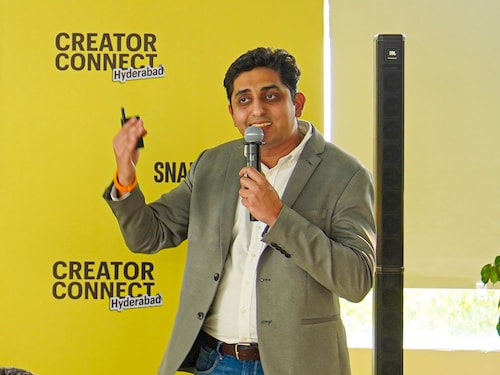'There is a shift from collaborating with just the biggest creator to the right
Saket Jha Saurabh of Snap talks about the evolution of the creator economy, brand collaborations, and how Snap is different from its rivals


In the last four years, the number of digital content creators has burgeoned from 9.6 lakh in 2020 to 40.6 lakh in 2024, according to a report published by Qoruz. Platforms such as Instagram, YouTube, Facebook and Snap have provided these creators the opportunities to share their content, collaborate with brands and generate revenue. Boundaries remain fluid, as creators share content and brand deals across platforms.
Snapchat has 250 million users in India, and globally has about 1 billion users every month. Last December, it introduced a monetisation programme for content creators and it came into effect in February this year. Although the company refused to disclose the number of content creators it has in India, Saket Jha Saurabh, director, head of content and AR partnerships, India, at Snap says it is a rapidly growing figure.
In a conversation with Forbes India, Saurabh talks about the evolution of the creator economy in India, how Snap stands out amid growing competition, and the safety of creators. Edited excerpts:
Q. How does Snap view the business of creators who are driving commerce on the platform?
Snap is a platform that is fundamentally for connecting with friends and family. We have built the ability for creators to leverage Snap: They can have both a private and a public experience on Snap. By creating a public profile, they can engage with their community, create content and scale their engagement. All major product categories are engaging with Snap creators, and a big reason for this is the popularity of the platform among Gen Z users.
There are two ways in which creators monetise on Snap: On-platform and off-platform. On the platform, we have a unified monetisation programme through which creators can share content on their stories or on spotlight [the short form video content on Snap]. This programme lets creators earn through a revenue share model with Snap. Under off-platform brand partnerships, the platform does not create revenue for creators directly brands reach out to Snap or its creators and they work directly with them. In general, we see a lot of business and excitement around Snap creators monetising their communities, both via Snap tools and avenues within the community.
Q. How has the ecosystem of collaborations evolved?
The creator industry in India has come a long way. The ecosystem has matured. Being a creator today is a valid profession. Among platforms, there are some things that are standard they all seem to have value for the creator"s ability to engage with a brand. Opportunities exist across platforms. What has changed, though, is the maturity of brands, especially those that have done this for a while they know what works better. In the initial years, brands would go after the most followed creators and viral trends. Today we have 377 million Gen Z consumers in India. Brands recognise that if you have to engage with this new audience, you have to operate in a manner they appreciate and on platforms they engage on.
That"s where Snapchat"s relevance comes into play. The platform recognises that it"s not just about being in front of this audience, but also about being there in the right manner. The shift from followership to engagement, from just the biggest or the largest creator to the right creator, and the focus on organic conversations are the shifts.
Q. How does Snap differentiate itself from competing platforms like Instagram or TikTok?
Fundamentally, Snap is different. We open in the camera, while every other platform opens in a feed. We have a worldview that everyone is a creator. On Snap, users follow their instincts of being themselves, of sharing a moment with their friends or family. That is the core ethos. Privacy is built in by design. We have launched multiple features, including ephemeral messaging. These have led to behaviour that is not performative, not based on pressure, and not based on virality.
Our best creators are also our best users. They become more evolved creators, and start having a public profile, while having a personal one. They can post to their close friends, while having a parallel, public presence. As a creator, you"re able to potentially not have comments or a pressure for likes. While we are in the same economy, trying to grow our business around content, we are different in how we approach creators. They understand that the reason why Snap works is because they can be themselves here. Hence, I don"t think we’re competing directly at all.
Of course, both creators and consumers can choose their platforms. In that context, we are potentially competing with a very wide swathe of platforms, but I really think we are in a category of our own.
Q. There have been instances of online backlash against creators. How does Snap address these challenges?
On Snap, safety is a very important aspect. It starts with product design and goes into what we do for creators outside of the immediate product. When you look at the product design itself, tools that give the ability to have public and private accounts, to switch off comments, to communicate with only friends and family if you want, ephemeral messaging, etc, are all design choices to focus on safety. We also have features like ‘Family Centre’ for teenagers, where parents and teenagers can have a productive, fruitful relationship, built on trust.
Second is our community guidelines that moderate content before it gets published, both through our AI and ML models, and through human moderation. We do education formats called ‘Snap schools’ that talk to creators about our guidelines, safety, privacy, and the right kind of content.
First Published: Aug 11, 2025, 17:28
Subscribe Now